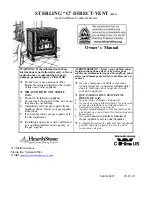
51
Combustion Chamber Coil Cleaning
Instructions
Before beginning this procedure, you must have on
hand the following items:
– a nylon, stainless steel or brass brush (not steel)
– “Rydlyme” (recommended for best results) or
“CLR”
– Gloves, eye protection
1. Shut down the XFyre boiler by using the following
steps:
a. Close the gas valve, shut down the unit and
wait for the unit to be cool to the touch.
b. Disconnect the condensate piping from the out-
side connection, (not from the XFyre boiler
side), so the flow from condensate reservoir
can be observed.
c. Disconnect electrical connections from the gas
valve, spark electrode and flame rectification
probe and combustion blower.
d. Remove the (4) screws on the aluminum ¾”
NPT connector on the right side of the gas
valve.
e. Disconnect the wiring connected to the com-
bustion blower motor.
f. Remove the (6) 10mm nuts from the burner
plate assembly.
g. Pull the entire burner plate assembly (with
blower still attached) towards you, while
removing or pushing aside any wiring to allow
the removal of the assembly.
2. Using a spray bottle filled with the recommended
product “RYDLYME” or “CLR”, spray liberally on the
coils, making sure the solution penetrates and fun-
nels down through the condensate system. If the
condensate system is blocked, let the chemical
penetrate for at least 15 minutes or until it drains.
3. Use the nylon, stainless steel or brass brush (do not
use steel) to scrub coils to remove any buildup, then
vacuum the debris from the coils.
Be sure to fol-
low the precautions listed for working with
ceramic fibers.
4. Spray the coils with clear water, making sure to con-
fine the spray to the area being cleaned (
DO NOT
get the back ceramic wall of the unit wet
). Flush
the combustion chamber with fresh water until clear
water runs from the condensate drain. At this point,
the XFyre should be ready to be re-assembled.
a. Inspect gaskets.
b. Re-install the burner assembly.
WARNING:
The combustion chamber insulation in this product
contains ceramic fiber material. Ceramic fibers can
be converted to cristobalite in very high temperature
applications. The International Agency for Research
on Cancer (IARC) has concluded that “Crystalline
silica inhaled in the form of quartz or cristobalite from
occupational sources is carcinogenic to humans
(Group1).”:
• Avoid breathing dust and contact with skin and
eyes.
• Use NIOSH certified dust respirator (N95).
This type of respirator is based on the OSHA
requirements for cristobalite at the time this
document was written. Other types of
respirators may be needed depending on the
job
site
conditions.
Current
NIOSH
recommendations can be found on the NIOSH
website at
http://www.cdc.gov/niosh/homepage.html.
NIOSH approved respirators, manufacturers,
and
phone numbers are also listed on this website.
• Wear long-sleeved, loose fitting clothing,
gloves, and eye protection.
• Apply enough water to the combustion chamber
lining to prevent dust
• Wash potentially contaminated clothes separately
from other clothing. Rinse clothes washer
thoroughly.
NIOSH stated First Aid:
Eye: Irrigate immediately
Breathing: Fresh air.






































